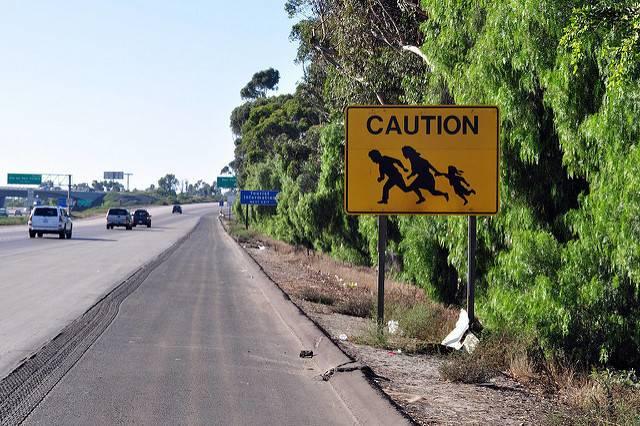
President Trump's promise to build a wall on the US-Mexico border just got a big push from the Department of Homeland Security (DHS).
On Tuesday DHS announced in a press release it would begin constructing a portion of the wall immediately and waive certain environmental requirements "to ensure the expeditious construction of barriers and roads" required for the wall's construction.
The department's decision is based on Section 102 of the 1996 Illegal Immigration Reform and Immigrant Responsibility Act (IIRIRA), which was passed during the George W. Bush era.
The act, which has been amended five times since its passage, charges DHS with the responsibility to "install additional physical barriers and roads (including the removal of obstacles to detection of illegal entrants) in the vicinity of the United States border to deter illegal crossings in areas of high illegal entry into the United States."
Section 102 (b) specifically gives DHS the power to construct "fencing and road improvements in the border are near San Diego California" and outlines the steps and powers DHS has at its disposal. That includes the ability to bypass certain environmental assessments.
According to the act, "[the] provisions of the Endangered Species Act of 1973 and the National Environmental Policy Act of 1969 are waived to the extent the Attorney General determines necessary to ensure expeditious construction of the barriers and roads under this section."
DHS has access to $12 million to complete the improvement without formal application to Congress and the funding " authorized to remain available until expended."
"The sector remains an area of high illegal entry for which there is an immediate need to improve current infrastructure and construct additional border barriers and roads," the department said on Tuesday.
The 15-mile section also cuts a swath through sensitive environmental lands established by US Fish and Wildlife outside of San Diego. Concerns about the environmental impact of the wall has prompted several lawsuits, including one by the Center for Biological Diversity and Rep. Raul Grijalva (D-Ariz.). It's also galvanizing push back from groups concerned about the wider impact of the Trump administration's immigration strategies. The League of Conservation Voters released a statement on Tuesday criticizing the administration's plan for a 700- to 900-mile-long border wall that would traverse several protected wildlife areas.
"If the Trump administration can’t reconcile their xenophobic border wall with dozens of environmental safeguards meant to protect our communities, that’s yet another reason Congress should deny funding," said LCV Vice President of Government Affairs Sarah Chieffo.
But in this case, it's unclear whether Congress could pull the funding from DHS, since the law gives it the ability to waive environmental assessments as well as designated funds to complete the task.
"Laws like the National Environmental Policy Act, the Endangered Species Act, the Solid Waste Disposal Act, and the Clean Water Act keep our families healthy. But driven by an anti-immigrant agenda, the Trump administration is callously putting construction of an environmentally and culturally destructive wall above water resources for communities on both sides of the border, federally protected lands, clean air, and the lives of hundreds of endangered species – all while turning a blind eye to the vital relationships of cross-border communities and our longstanding values as a nation," said Chieffo.
For its part, DHS states that it still intends to do its part to ensure environmental impact is minimized in all areas of construction.
"While the waiver eliminates DHS’s obligation to comply with various laws with respect to covered projects, the Department remains committed to environmental stewardship with respect to these projects. DHS has been coordinating and consulting -- and intends to continue doing so -- with other federal and state resource agencies to ensure impacts to the environment, wildlife, and cultural and historic artifacts are analyzed and minimized, to the extent possible."
One thing that is still unclear is the extent of the Trump administration's powers to use the IIRIRA to install sections of the border wall on a repeated basis. Can it become the fail-safe option for Trump's wall if Congress fails to come up with adequate funding on a "quick" basis?
While the latest House spending bill (passed last week) does allocate $1.6 billion of funding for the border wall, it's expected to encounter trouble in the Senate. Senate Democrats are expected to block its passage. Some Republicans may also refuse to endorse it since the total budget exceeds Department of Defense spending by more than $63.5 billion. With the clock ticking, the Trump administration may feel that it can at least implement part of the wall using a law that was at the time, expected to fortify borders against terrorists.
The 1996 IIRIRA also gives DHS other powers as well: the ability to negotiate with landowners to acquire land for the border wall and if necessary, to "commence condemnation proceedings." Environmental protections therefore, aren't the only issue hanging in the balance of a campaign promise that according to polls, most American voters now oppose.
Flickr images: Tony Webster; Allen Ormond; Jonathan McIntosh
Jan Lee is a former news editor and award-winning editorial writer whose non-fiction and fiction have been published in the U.S., Canada, Mexico, the U.K. and Australia. Her articles and posts can be found on TriplePundit, JustMeans, and her blog, The Multicultural Jew, as well as other publications. She currently splits her residence between the city of Vancouver, British Columbia and the rural farmlands of Idaho.














